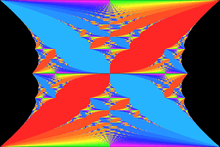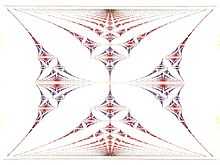Hofstadter's butterfly

In physics, Hofstadter's butterfly is a mathematical object describing the theorised behaviour of electrons in a magnetic field. It was discovered by Douglas Hofstadter in 1976, who later abandoned physics research and became notable as a cognitive scientist and author. It takes its name from its visual resemblance to a butterfly. It is a fractal structure and as such it shows self-similarity, meaning that small fragments of the structure contain a (distorted) copy of the entire structure. It is one of the rare fractal structures discovered in physics, along with KAM theorem.
To test whether Hofstadter's butterfly describes real electron behaviour requires accurate measurements. Such were not possible when he wrote his paper. However, more recent experimental research has confirmed the characteristic butterfly shape.
Background
Hofstadter described the structure in 1976 in an article on the energy levels of Bloch electrons in magnetic fields.[1] It gives a graphical representation of the spectrum of the almost Mathieu operator for  at different frequencies,
at different frequencies,
Written while Hofstadter was at the University of Oregon, his paper was influential in directing further research. Hofstadter predicted on theoretical grounds that the allowed energy level values of an electron in a two-dimensional square lattice, as a function of a magnetic field applied to the system, formed what is now known as a fractal set. That is, the distribution of energy levels for small scale changes in the applied magnetic field recursively repeat patterns seen in the large-scale structure.[1] "Gplot", as Hofstadter called the figure, was described as a recursive structure in his 1976 article in Physical Review B,[1] written before Benoit Mandelbrot's newly coined word "fractal" was introduced in an English text. Hofstadter also discusses the figure in his 1979 book Gödel, Escher, Bach. The structure became generally known as "Hofstadter's butterfly".
Confirmation

In 2013, two separate groups of researchers independently reported evidence of the Hofstadter butterfly spectrum in graphene devices fabricated on hexagonal boron nitride substrates.[2][3] In this instance the butterfly spectrum results from interplay between the applied magnetic field, and the large scale Moiré pattern that develops when the graphene lattice is oriented with near zero-angle mismatch to the boron nitride.
References
- ↑ 1.0 1.1 1.2 Douglas R. Hofstadter (1976). "Energy levels and wavefunctions of Bloch electrons in rational and irrational magnetic fields". Physical Review B 14 (6): 2239–2249. Bibcode:1976PhRvB..14.2239H. doi:10.1103/PhysRevB.14.2239.
- ↑ C. R. Dean, L. Wang, P. Maher, C. Forsythe, F. Ghahari, Y. Gao, J. Katoch, M. Ishigami, P. Moon, M. Koshino, T. Taniguchi, K. Watanabe, K. L. Shepard, J. Hone, and P. Kim (2013). "Hofstadter’s butterfly and the fractal quantum Hall effect in moiré superlattices". Nature 497: 598–602. Bibcode:2013Natur.497..598D. doi:10.1038/nature12186.
- ↑ L. A. Ponomarenko, R. V. Gorbachev, G. L. Yu, D. C. Elias, R. Jalil, A. A. Patel, A. Mishchenko, A. S. Mayorov, C. R. Woods, J. R. Wallbank, M. Mucha-Kruczynski, B. A. Piot, M. Potemski, I. V. Grigorieva, K. S. Novoselov, F. Guinea, V. I. Fal’ko and A. K. Geim (2013). "Cloning of Dirac fermions in graphene superlattices". Nature 497: 594–597. arXiv:1212.5012. Bibcode:2013Natur.497..594P. doi:10.1038/nature12187.
| |||||||||||||||||||||
